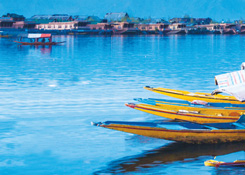
Srinagar, the land of peer fakirs, pristine beauty, and a chequered past, welcomes travellers to admire it and also look within
When the sun glimmers on the shimmering water of the placid Dal Lake on a mild summer afternoon, you would hardly wonder why this mesmerising "Paradise on Earth" has been a region so desperately desired by our neighbours over the past few decades. The city of Srinagar in summer gloriously welcomes you in the many colours of its gardens, the lakes and rivers brimming with water, and everything glitters; in winters, the snow melts your heart.
Srinagar's biggest drawcard, the gondolas, locally called “shikara” allure you to be a part of the legacy that they have been witness to for years. In fact the name of the shikaras also seem very suited to the surroundings. Khoobsurat, Nazaara -- the names say it all. Made of deodar tree wood and approximately 15ft in length, these sikharas have a vibrant colour that makes them stand out amongst other boats. These shikaras can be hired from boat stations all along the lakeshore and official rates are displayed on noticeboards.
When in Srinagar, a visit is not complete if you do not stay in the houseboats – elegantly designed structures that are a piece of art. A night-over in the iconic houseboats gives a complete floating residential experience. These indulgent houseboats offer the most tranquil and soothing experience in the splendid silence of the night. These floating mini-hotels are fitted with every comfort and it is the most idyllic way to relax. The furnishings, mostly made of cedar, are often lavish and the service, firstclass. Almost all houseboats have a comfortable bedroom and a viewing balcony. As you wake up to the misty peaks of the Pir Panjal mountains, let the flower sellers bring perfumed blossoms to your doorstep.
The shore line of the lake (about 15.5 kilometres) is encompassed by a boulevard lined with Mughal era gardens, parks, houseboats and hotels. Scenic views of the lake can be witnessed from the shore line Mughal gardens, such as Shalimar Bagh and Nishat Bagh built during the reign of Mughal Emperor Jahangir. Though almost all have a fundamentally similar design with terraced lawns, fountain pools and carefully manicured flowerbeds interspersed with mighty chinar trees, pavilions and mock fortress facades, the most famous garden is Shalimar Bagh.
This beautiful garden was originally named the Farah Bakhsh or “Delightful garden”, but today it is known as the “Garden of love”. Shalimar Bagh has an air of solitude with the amazing fountains and shaded lined trees that seem to retire towards the snow clad mountains. A sound and light show is held here every evening between May to October when tourist pour in.
Though Nishat Bagh is smaller than Shalimar Garden, it is more impressive, what with steeper terracing and a lake-facing panorama. Built by Asaf Khan, Empress Nur Jahan’s brother, Nishat is celebrated for its stately chinar trees, imported to Kashmir from Persia by the Mughals. Among these, many of the giant chinar trees have been planted by the Mughal Emperors. Nishat has 12 terraces representing the 12 signs of the zodiac, which seems to gradually descend and merge in the Dal Lake’s periphery.
Although Srinagar has borne the brunt of intercommunal tensions, cross-border terrorism, and fell off the tourist map after the onset of militancy, the city retaliated to normalcy of late and has been seeing tourist footfalls once again with foreign tourists gradually trying to rediscover the region.
As you discover the area around the lake, the Dalgate is where the city coalesces. Take time to absorb the medieval-looking backstreets of Srinagar where wooden houses with delicately carved balconies beg for your attention. As music drifts out from the cafes, the smell of fresh bread wafts out from bakeries. The Khanqah of Shah Hamdan is said to be Srinagar’s most beautiful buildings. The Sri Patap Singh Museum houses the regional history and culture and the Arts Emporium caters for local crafts. The Lal Chowk is Srinagar’s city square with shops and restaurants on all sides, including the streets which border the square.
The pagoda-style Shah Hamadan Masjid on the banks of the Jhelum River was originally constructed in the 14th century for Sultan Sikander. It combines Buddhist, Hindu and Islamic influences and has two stories of intricate carvings and the interior has ornate chandeliers. A must-visit if you are in that area.
The silvery white Hazratbal Mosque is revered for housing a relic, the Prophet’s hair. Situated near the Dal Lake, the only domed mosque in Srinagar is a place of serenity, a must visit. The Hazratbal Mosque lends a historic and divine appeal to Srinagar. As you walk down the corridors of this famous religious sanctum, you marvel at the intricate Persian and Iranian architectural influences.
Set atop the Gopadari Hill is the Shankaracharya Temple, sacred to the Buddhists for centuries. A great place to admire the stunning panorama 1000 feet above the Kashmir plain with impressive views of the Srinagar, Dal Lake, Kashmir Valley and surrounding mountains. Be there for the best view of the place.
